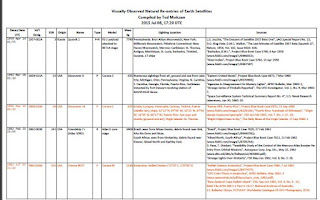One of the reports on the recently obtained Western Australia Police Department file (click here) occurred in October 1974, and caught the eye of Ted Molczan, an amateur astronomer. Ted is particularly interested in artificial satellites, and the observations of satellite re-entries.
Over the past three years Ted has been compiling a table of sightings of natural re-entries of orbiting objects. Interestingly, as Ted pointed out to me, "UFO reports have proven a goldmine of previously unknown re-entry sightings. For example, UFO sighting reports in Australian government archives yielded more than a dozen previously unknown re-entry sightings."
As mentioned above, Ted was specifically interested in the October 1974 sighting, dated 14 Oct 1974 on the file which was "...exactly 24 hours earlier than a re-entry I previously identified that had been reported as a UFO from Fitzroy Crossing, WA and Katherine, NT. The object was the Agena D upper stage (1966-110B/2609)from the launch of ATS1..."
I forwarded Ted a copy of the Police Department file in order that he could read the original documents. He later replied that he found evidence on the file that the 14 October date was incorrect and that the UFO sightings probably happened on 15 October. Ted ended his thorough analysis with "Despite the noted imperfections, the overall agreement with the known re-entry trajectory and the appearance of a re-entry fireball is strong."
Ted kindly sent me the latest version (27 pages) of his "Visually observed Natural Re-entries of Earth Satellites" table. The table contains numerous examples of UAP reports caused by satellite re-entries over Australia. I am currently cross checking this table against my catalogues of Australian UAP.
Update 10 August 2015:
I asked Ted whether or not the following sightings might be of a re-entry?
19 July 2006
Wirrabara Forest to Quorn and Hawker SA 1330hrs DO/IFO?
“So was it a
meteorite or space junk falling to earth? No one knows. But at 1.30pm in the
afternoon of July 19, many people across the Mid North of South Australia -
from Ted's response was as follows:
"Probably not a re-entry. None were expected at the time and I have yet to find a confirmed credible daylight sighting of a re-entry. Typical objects reach about mag -8 at 100km which might be detectable to the naked eye if the observer knew where to look, but not by chance sighting. A huge object like one of the space stations, would be visible."




No comments:
Post a Comment